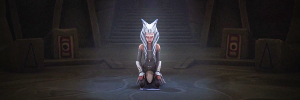1. In this chapter Caspian meets other Narnians in hiding, including other red dwarfs, badgers, and black dwarfs. Why do you think Lewis chose to have Nikabrik, Trumpkin, and Trufflehunter room together instead of with others of their kind?
2. This chapter starts rather like an Enid Blyton story or other children's tale. When do you notice the difference, and what are those differences?
3. The Old Narnians have differing opinions about Caspian and Aslan. Why do some of them still believe in Aslan while others don't? What other observations do you have about the Old Narnians that Caspian meets?
4. Caspian witnesses the conjunction of Tarva and Alambil years before Glenstorm explains the meaning to him. Why do you think there is this gap?
5. Are Glenstorm's words a crossroads for Caspian and the old Narnians?
6. What do you think of Lewis's names for the Old Narnians? Do you have any favourites?
1. In this chapter Caspian meets other Narnians in hiding, including other red dwarfs, badgers, and black dwarfs. Why do you think Lewis chose to have Nikabrik, Trumpkin, and Trufflehunter room together instead of with others of their kind?
That's a good question. They do seem to live closer to Telmarine lands than the others - perhaps they're, more or less, manning a sort of outpost, to give their fellows advance warning in case humans start coming closer to their woods?
2. This chapter starts rather like an Enid Blyton story or other children's tale. When do you notice the difference, and what are those differences?
I admit, I've never read an Enid Blyton story, so I can't speak too closely to the similarities. The difference between this chapter and the others, though, is that it's mainly a way to introduce us to all the different creatures who still live in Narnia in hiding - aside from them finding out about Caspian and Glenstorm's mention of going to war, it doesn't really advance the plot per se. Every chapter before this has been about moving along the story, whereas this one slows down to show us more of Narnia. It's a lot more laid-back and magical, in a way that we haven't seen as much of in this book thus far.
3. The Old Narnians have differing opinions about Caspian and Aslan. Why do some of them still believe in Aslan while others don't? What other observations do you have about the Old Narnians that Caspian meets?
One thing I notice is that the Narnian who accept Caspian the most easily and still seem to believe in Aslan are mostly Talking Beasts. The ones with the most reservations are the Dwarfs, fitting with what Trufflehunter said about dwarfs being as "changeable as the humans themselves", whereas the beasts remember. The centaurs also accept Caspian easily, but they are also stargazers, and we know that Glenstorm has likely had some idea of this coming for at least a few years, given that he's already seen the conjunction of Tarva and Alambil. At any rate, I think it all comes down to whether they still accept that any humans belong in Narnia - and I think that the creatures who still believe in Aslan and the sovereignty of his statement that Narnia is meant to be ruled by a man have an easier time accepting Caspian.
4. Caspian witnesses the conjunction of Tarva and Alambil years before Glenstorm explains the meaning to him. Why do you think there is this gap?
You'll note that the conjunction happened the same night that Cornelius met with Caspian to tell him the truth about Old Narnia, and to begin Caspian in earnest down the path towards being the first true Narnian King that Narnia had seen in generations. I don't think it's an accident that these two meetings happened on the same night.  Glenstorm, being an experienced stargazer, likely understands why the signs appear in the sky well before he could see the signs in the "real world", but the conjunction was so important that he would not forget it, and now that he sees it happening before his eyes, he recognizes that the two are connected.
Glenstorm, being an experienced stargazer, likely understands why the signs appear in the sky well before he could see the signs in the "real world", but the conjunction was so important that he would not forget it, and now that he sees it happening before his eyes, he recognizes that the two are connected.
5. Are Glenstorm's words a crossroads for Caspian and the old Narnians?
I think so. For generations, the Old Narnians have been living in hiding; for years, Caspian has been somewhat passively waiting for Miraz to die or to become old enough to become King so he could make things right. Glenstorm is the first one to suggest a proactive plan - go to war against the Telmarines and Miraz's rule. I don't think any of them even really thought it was possible up to this point, but Glenstorm assured them that it is - he's seen it. Caspian and the old Narnians have to decide whether or not they trust his word, of course.
N-Web sis of stardf, _Rillian_, & jerenda
Proud to be Sirya the Madcap Siren
1. In this chapter Caspian meets other Narnians in hiding, including other red dwarfs, badgers, and black dwarfs. Why do you think Lewis chose to have Nikabrik, Trumpkin, and Trufflehunter room together instead of with others of their kind?
Surprisingly enough, the three of them seemed to get along well, even when they didn't always agree. Any one of them could surely have gone and lived elsewhere if they had so desired. It gave a nice mix of three different perspectives--the loyal, the skeptical, and the downright disbelieving. And we find out that they are quite representative--most black dwarfs tend to be suspicious, for example.
2. This chapter starts rather like an Enid Blyton story or other children's tale. When do you notice the difference, and what are those differences?
It turns up pretty quickly that this is not quite typical--the creatures they meet, for one thing--though if you read E Nesbit, it is a little closer to the way she would do things. At this point, Caspian is the only human, and it remains that way for a good bit of the story. And there's no little dog, or other pet--decidedly un-Blytonish 
3. The Old Narnians have differing opinions about Caspian and Aslan. Why do some of them still believe in Aslan while others don't? What other observations do you have about the Old Narnians that Caspian meets?
Seeing is believing for some people? It took Trumpkin a long time to change his mind. Most of the creatures appeared to be remarkably willing to accept Caspian at face value--as King even--though few of them were likely to have had positive interactions with humans in the past. Hospitality was quite the thing, it would seem, at least among the animals.
4. Caspian witnesses the conjunction of Tarva and Alambil years before Glenstorm explains the meaning to him. Why do you think there is this gap?
I'm reminded of the gap between the birth of Christ and the arrival of the Magi. Not that Lewis was necessarily thinking of that, but that it seems as if signs in the heavens can be of longer duration or much earlier than the events they foretell.
5. Are Glenstorm's words a crossroads for Caspian and the old Narnians?
Most of them seem quite content to continue on in their ordinary lives. It is not until the Centaurs speak of war that they really consider it. And then they do not doubt it at all.
6. What do you think of Lewis's names for the Old Narnians? Do you have any favourites?
I have to admit that my Latin is very poor, so I dug out one of my Latin-English dictionaries to look up the faun names. I had hoped that they would be something along the lines of that esteemed author "Pulverulentus Siccus" ie. Dusty Dry, but didn't come up with anything. Now I do wonder if Lewis was having his own private fun with those names? Would a reader who was familiar with Latin--as many would have been when he wrote it--have appreciated the joke more? Or was he merely inventing names in the Latin fashion, corrupting a letter here and there?
My favourite line in the chapter: "It took him a long time afterwards to get unsticky."
Now my days are swifter than a post: they flee away ... my days are swifter than a weaver's shuttle
1. In this chapter Caspian meets other Narnians in hiding, including other red dwarfs, badgers, and black dwarfs. Why do you think Lewis chose to have Nikabrik, Trumpkin, and Trufflehunter room together instead of with others of their kind?I think it was a way to introduce the 3 categories of Narnians Caspian would meet: Narnians who believe in the old stories and Caspian; Narnians who can be persuaded to follow Caspian yet do not believe in the Old stories; Narnians who will do whatever it takes to reclaim Narnia.
2. This chapter starts rather like an Enid Blyton story or other children's tale. When do you notice the difference, and what are those differences?
I am not familiar with Enid Blyton and cannot think of other children's tales like this.
3. The Old Narnians have differing opinions about Caspian and Aslan. Why do some of them still believe in Aslan while others don't? What other observations do you have about the Old Narnians that Caspian meets?
Some have enough faith to believe in an absent Aslan and some do not. The ones who don't probably don't believe because they see know
4. Caspian witnesses the conjunction of Tarva and Alambil years before Glenstorm explains the meaning to him. Why do you think there is this gap?
Well, I guess it could be considered that the conjunction was the beginning of "something good" for Narnia. I do think it is odd that it took a while to actually happen. I suppose it works fine though since Glenstorm understood the connection.
5. Are Glenstorm's words a crossroads for Caspian and the old Narnians?
Yes, they given them a direction that they had not imagined.
6. What do you think of Lewis's names for the Old Narnians? Do you have any favourites? The animal names seem to reflect their characters or the characteristics of their species. They seem to belong in a children's book. The faun's names seem to have a more mythical and maybe Latin based? I like Pattertwig, Hogglestock, and Reepicheep.

NW sister to Movie Aristotle & daughter of the King

